76 Industrialization in Sub-Saharan Africa
economies are more significant than urbanization economies (Henderson, Kuncoro, and Turner 1995). Despite their predominantly agrarian base, Sub-Saharan African countries are undergoing rapid urbanization. In 2018, the region’s rate of urbanization was 40 percent (World Development Indicators, The World Bank). With regard to agglomeration economies, city size and population density tend to have significant effects on productivity and employment (Collier, Jones, and Spijkerman 2018). However, such agglomeration effects are weaker for cities in Sub-Saharan Africa relative to cities in Asia and Latin America. Urbanization may be driven by the formation of consumption cities that have emerged because of discovery, production, and export of resource commodities and that, in such cases, are unlikely to result in agglomeration economies. Urbanization in Côte d’Ivoire and Ghana displays these features (Gollin, Jedwab, and Vollrath 2016 ). Similarly, it seems that population density has not generated employment growth in Ghanaian manufacturing, which is also more likely to occur in other resource-rich countries.11 By contrast, among Ethiopian firms, a study shows a positive and significant relationship between agglomeration and physical productivity of firms producing the same product. This finding strongly suggests that agglomeration comes with competitive pressure, forcing firms to improve their efficiency, along with positive spillover effects (Bigsten et al. 2012). More generally, however, the estimates of agglomeration effects are rather weaker than expected in SubSaharan African countries (Siba and Söderbom 2015), but this does not mean there is no potential for agglomeration as a key driver of productivity growth and job generation.
Market Structure, Entry Regulation, and Productivity There are considerable cross-country productivity gaps and income differences, which partly reflect large magnitudes of resource misallocation in poor economies compared with developed economies. Recent findings show substantial misallocation in Sub-Saharan African agriculture, services, and manufacturing.12 These results provide the context for the extent of misallocation in Sub-Saharan Africa, given that manufacturing is a rather small fraction of the economy in these countries. Key sources of resource misallocation are entry barriers and the resultant market structure. The extant evidence shows that entry costs, which are considerably higher in poor countries, lead to lower productivity and output levels because of misallocation. Entry costs also explain a great portion of the cross-country differences in productivity and income. A study shows that countries in the bottom 10 percent of the entry cost distribution have higher TFP and labor productivity compared with

